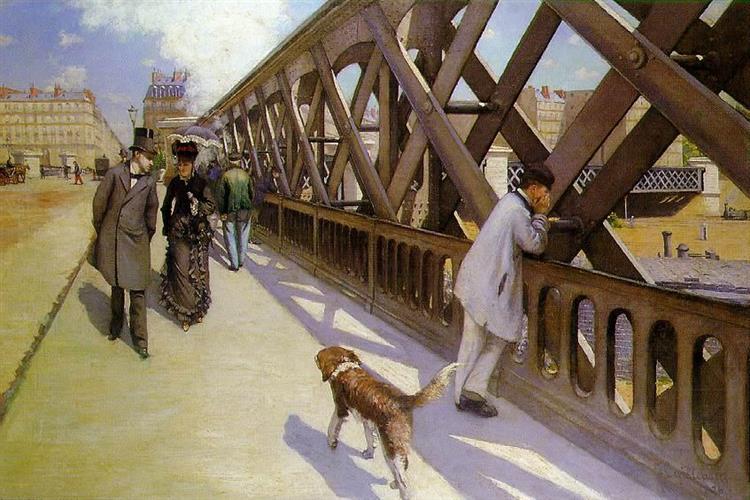
Gustave Caillebotte’s “Le Pont de l’Europe” stands as a monumental piece in the tapestry of 19th-century art, encapsulating the essence of Parisian urban life during a period of profound transformation. This article seeks to delve into the rich layers of this masterpiece, exploring its historical context, artistic significance, and lasting impact on the world of art.
The Birth of an Urban Masterpiece
Le Pont de l’Europe was created during a time of great change in Paris. The city was undergoing Haussmannization, a series of massive urban renewal projects initiated by Emperor Napoleon III and carried out by his prefect, Baron Haussmann. This period saw the reconstruction of Paris with new boulevards, parks, and public works, significantly altering the city’s landscape and the daily lives of its inhabitants.
Caillebotte, an active member of the Impressionists, was fascinated by this new urban environment. In Le Pont de l’Europe, he captured the essence of modern Parisian life, illustrating the intersection of the old and the new. The painting depicts the famous bridge in the Saint-Lazare district, a symbol of modernity and industrial progress.
Caillebotte’s Unique Perspective
Unlike his contemporaries who often focused on more traditional Impressionist subjects like landscapes and leisure activities, Caillebotte was drawn to urban scenes and the rhythm of city life. His approach to painting was characterized by a unique perspective and a keen interest in architectural details.
In Le Pont de l’Europe, Caillebotte employed a radical perspective, creating a sense of depth and movement. The viewer’s eye is drawn to the convergence of lines in the composition, mirroring the convergence of different walks of life on the bridge – a metaphor for the social changes occurring in Paris at the time.
A Glimpse into Parisian Society
The painting not only captures the physical transformation of Paris but also offers a glimpse into the social dynamics of the era. The figures depicted in the painting – from the well-dressed bourgeoisie to the working-class individuals – represent the diverse social fabric of Paris. Caillebotte’s attention to detail in the depiction of these figures speaks to his interest in the social realities of his time.
The Influence of Photography
Caillebotte’s work was notably influenced by the emerging art of photography. The framing and composition of Le Pont de l’Europe show similarities to photographic techniques, particularly in the way Caillebotte captured a moment in time, with figures seemingly in motion. This influence marked a departure from the traditional approaches to painting and signalled a new way of seeing and representing the world.
The Reception and Legacy of the Painting
Upon its completion, Le Pont de l’Europe was met with mixed reactions. While some praised Caillebotte’s innovative approach and technical prowess, others were critical of the painting’s modern subject matter and unique perspective. Despite this, the painting has since been recognised as a pivotal work in the history of art, showcasing Caillebotte’s role in bridging the gap between traditional and modernist approaches to painting.
The Preservation of Caillebotte’s Legacy
Today, Le Pont de l’Europe is celebrated as a masterpiece of Impressionist art, housed in a prominent museum where it continues to inspire and captivate audiences. The preservation of Caillebotte’s work, including this iconic painting, is a testament to his enduring impact on the art world and his contribution to our understanding of urban life in the 19th century.
FAQs about Le Pont de l’Europe by Gustave Caillebotte
-
What year was Le Pont de l’Europe painted by Gustave Caillebotte? Le Pont de l’Europe was painted in 1876, during a significant period of urban transformation in Paris.
-
Where is Le Pont de l’Europe displayed? This masterpiece is displayed in a renowned art museum, contributing to the preservation of Caillebotte’s artistic legacy.
-
What artistic movement is Caillebotte associated with? Gustave Caillebotte is associated with the Impressionist movement, known for its portrayal of modern life and innovative techniques.
-
What is significant about the bridge depicted in the painting? The bridge, Le Pont de l’Europe, symbolizes the modernization and industrialization of Paris in the 19th century.
-
How did Caillebotte’s approach differ from other Impressionists? Unlike many of his contemporaries, Caillebotte focused on urban scenes and used unique perspectives influenced by photography.
-
What themes are explored in Le Pont de l’Europe? The painting explores themes of urban transformation, social dynamics, and the intersection of different walks of life in modern Paris.
Conclusion Gustave Caillebotte’s Le Pont de l’Europe is more than just a painting; it is a historical document that captures a pivotal moment in Parisian history. Its innovative composition, attention to social realities, and the influence of photography mark it as a significant work in the canon of Impressionist art. Caillebotte’s ability to encapsulate the spirit of his time in this masterpiece ensures that it continues to resonate with audiences today, inviting us to reflect on the ever-changing landscapes of our own cities.
























